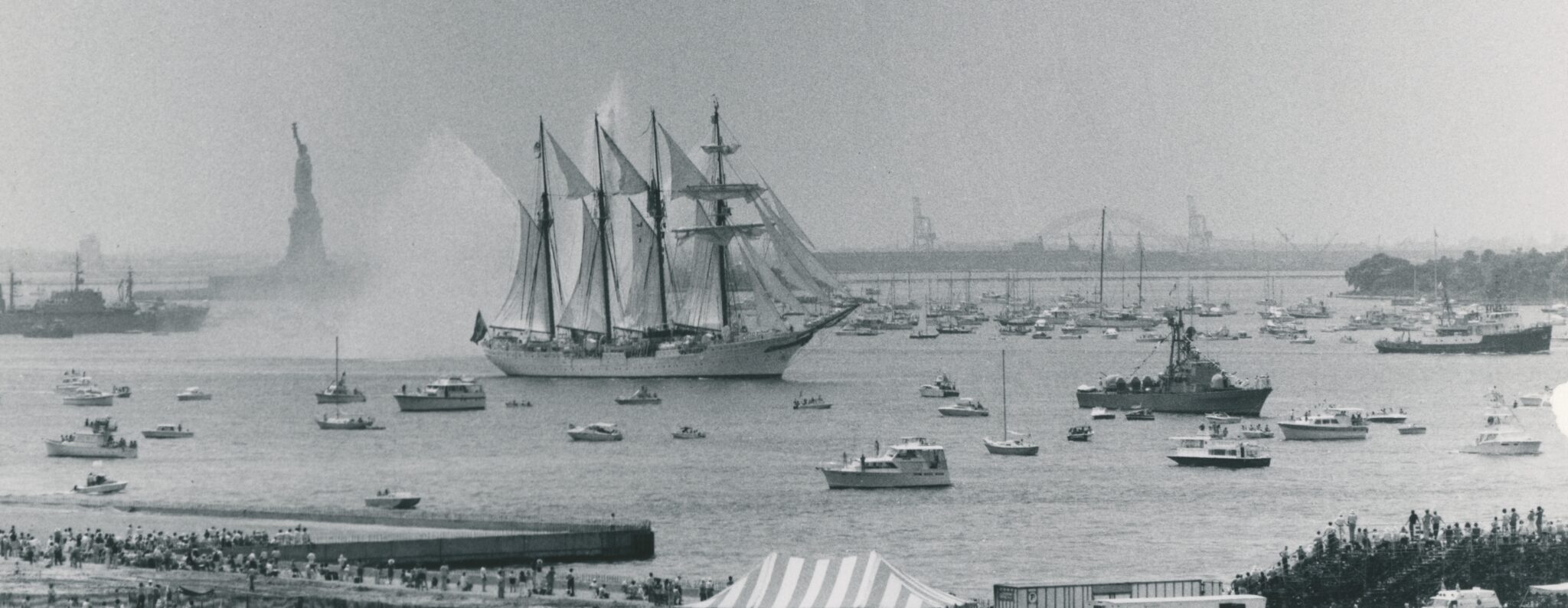Danmark’s visit and centuries of ship demonstrations
A Collections Chronicles Blog
by Martina Caruso, Director of Collections
September 16, 2022
For centuries, sailors and their ships were the lead forces in bringing the world closer together. Today, international sail training vessels foster such a long tradition of understanding across nations and cultures, providing sail training and inspiration to young people around the world.
On the occasion of one of these sail training vessels, the tall ship Danmark, visiting South Street in mid-September, I did a quick dive into our archives and special collections to see what we have about her many visits to New York City over the decades. During my search I found exciting material covering Danmark, but I also discovered images and articles about other visiting vessels, naval parades, and international sailing events that have taken place in New York Harbor over the centuries which fosters today’s tall ship and maritime communities.
Parade of Ships
From the Narrows to up the Hudson River, New York Harbor offers a great setting for water spectacles, and along with navigable waterways, the Harbor also promises large crowds and many places for viewers to watch from.
One of the first notable maritime celebrations was held in honor of George Washington (1732-1799) in 1789 when he arrived to be inaugurated as the first President of the United States. A barge was specially built to carry Washington to the foot of Wall Street, accompanied by dozens of boats and a thirteen-gun salute from a visiting Spanish navy vessel.

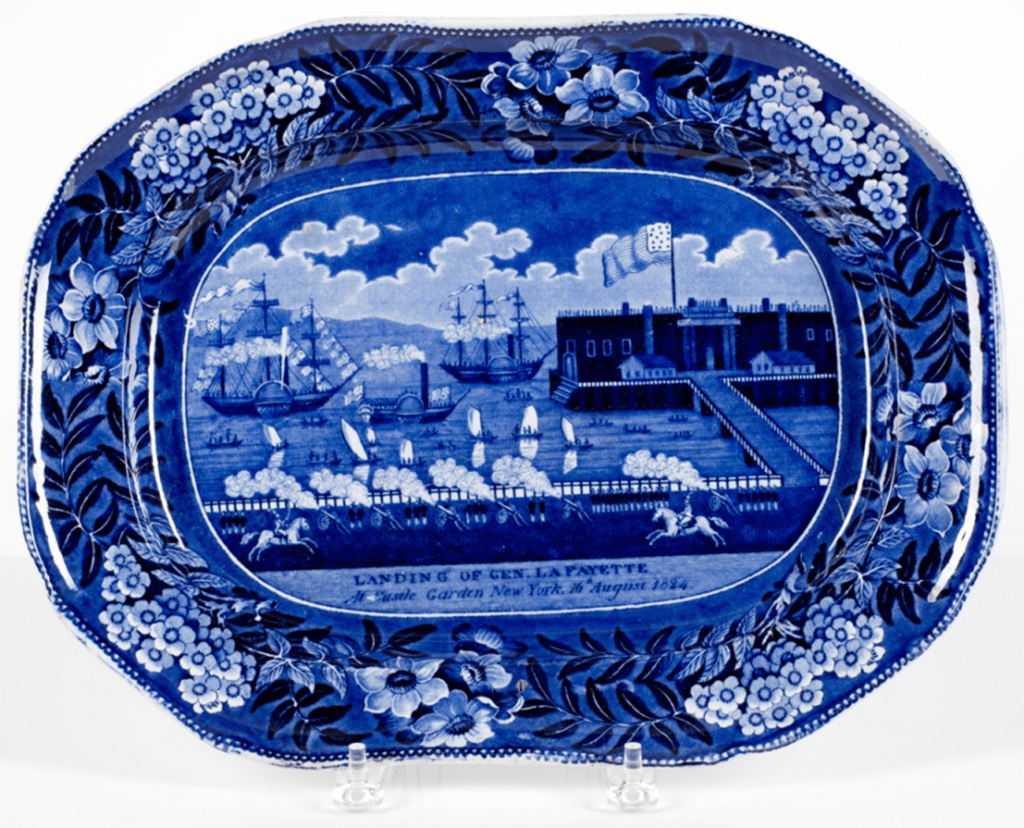
Left: Virtue & Yorston, New York (American, active ca. 1859 – ca. 1880) publisher; “Reception of President Washington at New York. April 23rd 1789.” ca. 1860. Seamen’s Bank for Savings Collection, South Street Seaport Museum 1991.078.0030
Right: James and Ralph Clews, manufacturer. “Landing of Gen. Lafayette at Castle Garden Platter” ca. 1824-1835. Porcelain. Museum Purchase 1995.003.0034
Similar “heroes welcomes” would continue through the 19th and 20th centuries. From a procession for the Marquis de Lafayette (1757-1834) in 1824 (which was charmingly depicted on a Staffordshire platter in the Museum’s collection), to a celebration for famous aviator Charles Lindbergh (1902-1974) in 1927, New York Harbor was a venue to reinforce ideas of American triumphs and exceptionalism. Though harbor parades nearly always included working and civilian vessels (often carrying spectators), maritime celebrations were also an opportunity to encourage national pride with displays of United States naval excellence. A few other examples noted in our collections include:
- June 18, 1910, a parade was dedicated to Theodore Roosevelt (1858-1919), former president of the United States, on his return from an African safari. As President Roosevelt entered New York Harbor on the ocean liner Kaiserin Auguste Victoria, he was greeted by cheering crowds, an extravagant naval display, followed by a water parade of almost one hundred vessels, and a twenty-one-gun salute.
- June of 1930, Rear Admiral Richard E. Byrd (1888-1957) was greeted by 13 gun-salute, a marine pageant consisting of more than 23 vessels, a ticker-tape procession including more than two thousand soldiers, sailors, marines, and National Guardsmen, for his first Antarctic expedition and flight over the South Pole.
- May of 1939, with the 1939 World’s Fair underway in New York, Rear Admiral Alfred Johnson (1876-1963) and his estimated 11,700 navy officers and crew of the Atlantic Squadron on board 32 men-of-war vessels, were greeted by crowds of over two hundred thousand, all eager to view the battleships and cruisers that made up the Atlantic Squadron in New York Harbor.
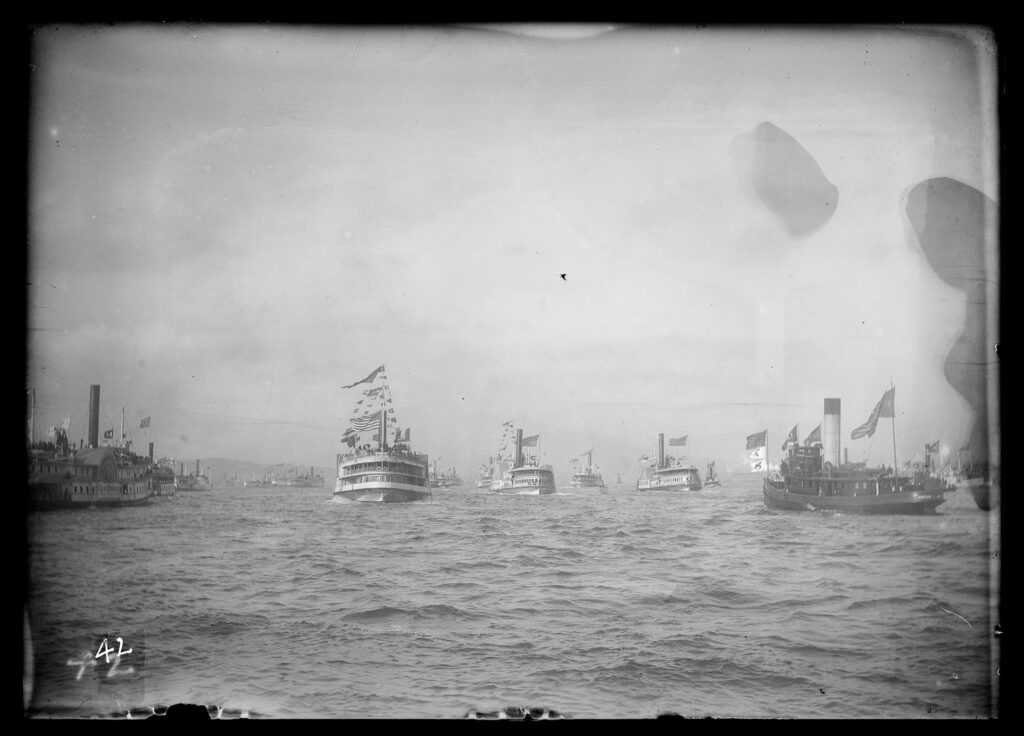
Thomas W. Kennedy (American, active ca. 1890-1915), [Dewey Day Naval Parade on the Hudson River] September 29, 1899. Silver gelatin dry plate negative. Thomas W. Kennedy Collection 2016.003.0042
No partial list of maritime “heroes welcomes” in New York would be complete without mentioning the Dewey Day Parade of 1899 held in honor of Admiral George Dewey (1837-1917). The one-sided Battle of Manila Bay the year before during the Spanish-American War had marked a United States triumph over a European colonial power, and contributed to Spain ceding territorial control of the Philippines to the US. Though this would lead to the horrific Philippine–American War against the First Philippine Republic, the mood in 1899 New York was festive. A two-day celebration included Dewey’s flagship USS Olympia, 18 Naval vessels, 5 revenue cutters, 93 steam yachts, and over 200 steamboats, tugboats, and barges.
Maritime History Makes a Splash
Marine celebrations weren’t limited to celebrating famous visitors to New York City. Parades of ships had accompanied the opening of the Erie Canal in 1825 and the unveiling of the Statue of Liberty in 1886. Harbor demonstrations were also used to celebrate anniversaries and historical events.
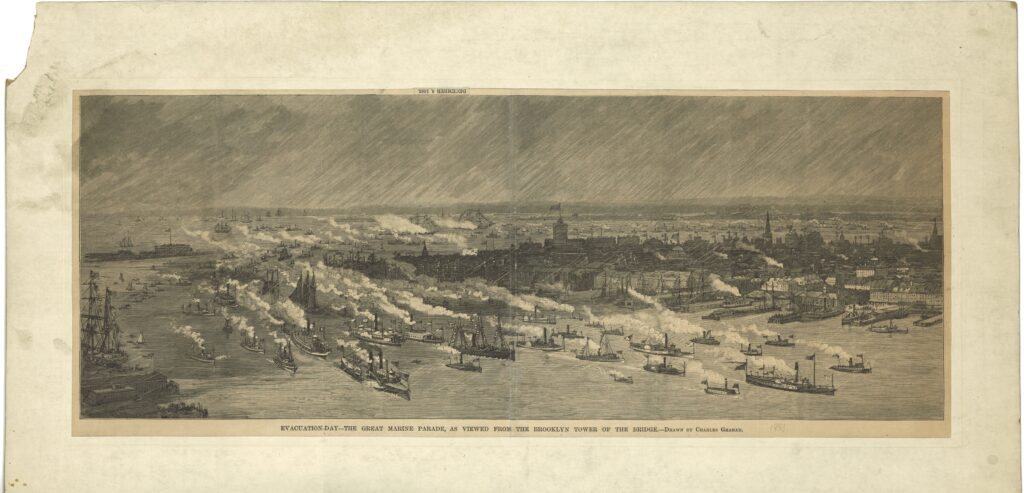
Charles Graham (American, 1852-1911), Harper’s Weekly, publisher. “Evacuation Day – The Great Marine Parade as Viewed from the Brooklyn Tower of the Bridge” December 8, 1883. Peter A. and Jack R. Aron Collection, South Street Seaport Museum 1991.070.0144
In 1883 New York City celebrated Evacuation Day with a naval parade celebrating the anniversary of the British evacuation of New York City during the Revolutionary War on November 25, 1783. This view, engraved from sketches taken from the Tower of the uncompleted Brooklyn Bridge, shows the pageant from the Brooklyn tower of the newly opened Bridge. Aside from the fleet of ships, this view also shows the 19th-century seaport district. The Fulton Ferry is bustling with steam ferries and there are several fishing schooners at the Fulton Fish Market slip. Even Schermerhorn Row, the row of 1810-1812 counting houses that stands today as one of the oldest commercial structures in Manhattan, is accurately depicted; the mansard roof that was erected over 93-92 South Street in 1868 can be clearly identified.
Another New York Harbor marine parade that is well documented in our collection is the Hudson-Fulton Celebration. The festivity was held from September 25 through October 11, 1909 to commemorate two separate, but related events: the 300th anniversary of Henry Hudson (ca.1565–1611)’s exploration of the river that came to bear his name, and the 100th anniversary of Robert Fulton (1765–1815)’s invention of the steamboat Clermont.
Ceremonies and parties were organized in New York City and in cities and towns along the Hudson River, including a wide variety of events from nighttime electrical displays, and a series of biplane flights along the river by Wilbur Wright (1867-1912), to swimming and boating contests, and special exhibitions at various New York City institutions. The Staten Island Shipbuilding Company built a replica of Fulton’s Clermont, and the United States Postal Service issued 50 million Hudson-Fulton commemorative stamps, which were sold in New York, Boston, Chicago, Detroit, Philadelphia, Saint Louis, and Washington.
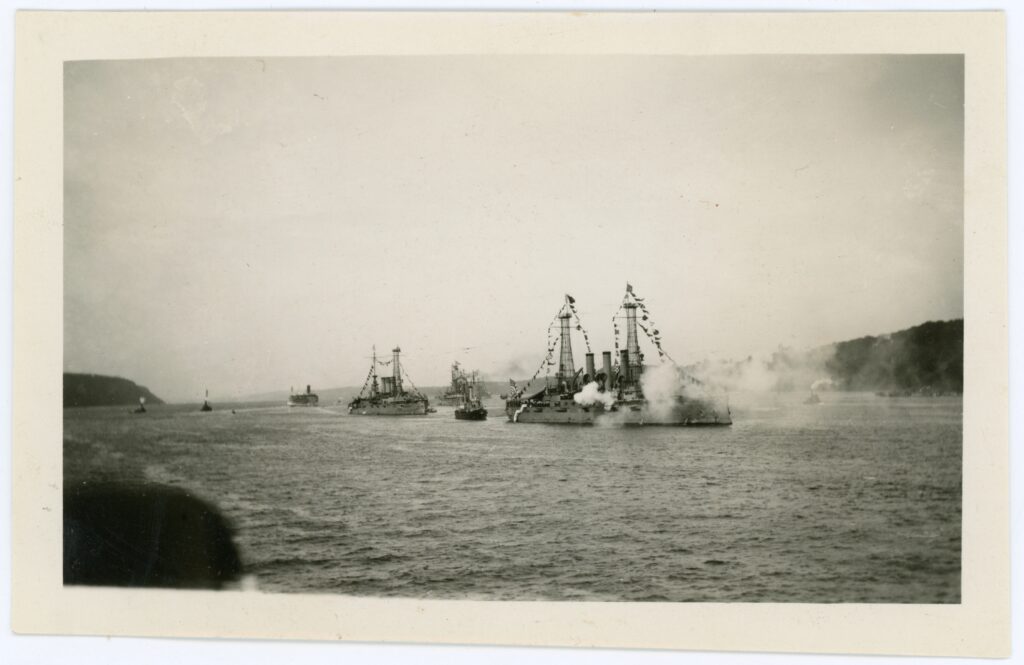
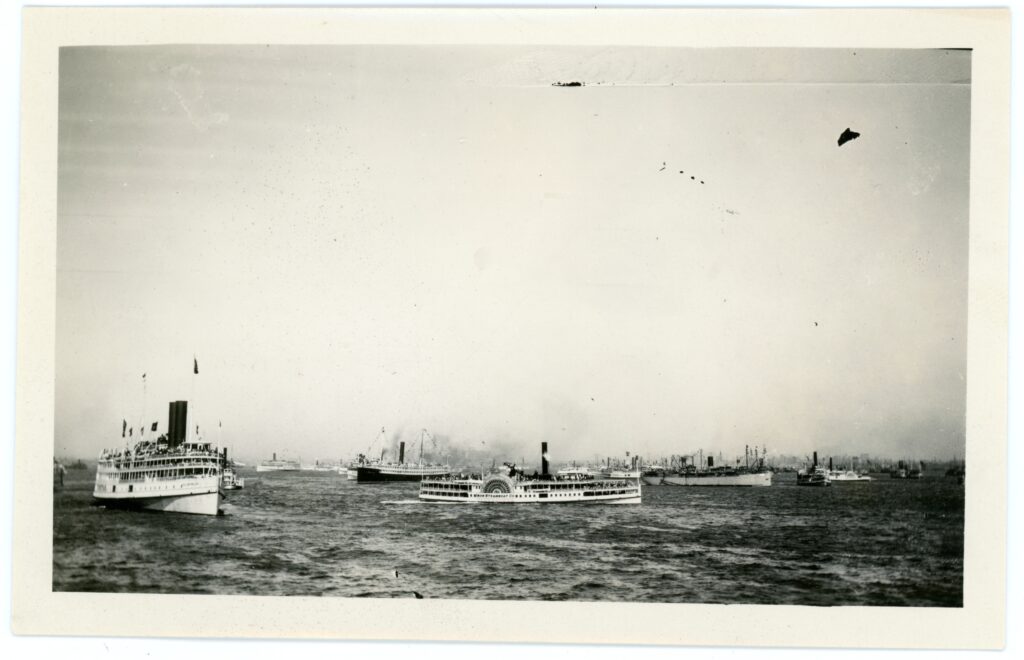
Left: Cleveland Arthur Dunn (American 1873-1956), [USS Connecticut firing salute as part of the 1909 Hudson-Fulton Celebration] September 25, 1909. Photographic print. Gift of Joan A. Wright, 2006.019.0020
Right: Cleveland Arthur Dunn (American 1873-1956), [Iron Steamboat Company’s Cetus parading in the Hudson River] September 25, 1909. Photographic print. Gift of Joan A. Wright, 2006.019.0004
Though these celebrations can still be examined as expressions of American nationalism, the groundwork for maritime parades as an exercise in international cooperation was already present. From the visiting Spanish warship that saluted George Washington in 1789 to the numerous ships that visited for the Words Fair in 1939, the cosmopolitan character of New York City and the maritime world was nearly always seen in harbor events.
Operation Sail
In the mid 20th century a new type of ships’ parade was put into motion called Operation Sail–also known as OpSail. Founded as a non-profit organization established to foster global goodwill amid growing Cold War tensions, the organization flourished in the second half of the century, promoting cooperation between nations as well as celebrating maritime history and sail training efforts around the world.
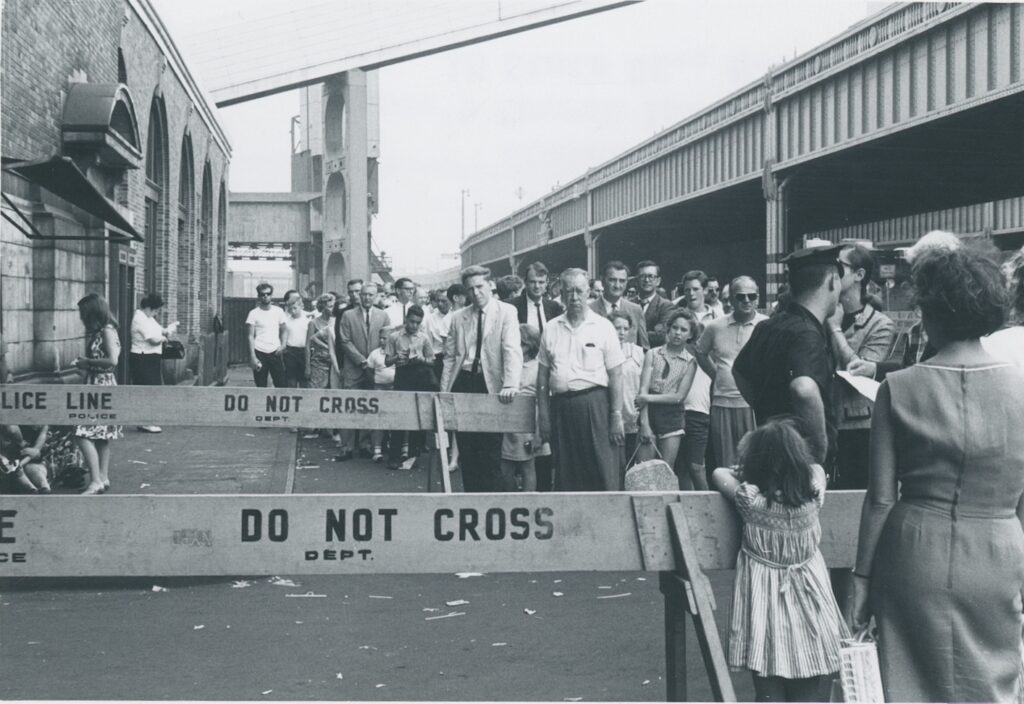
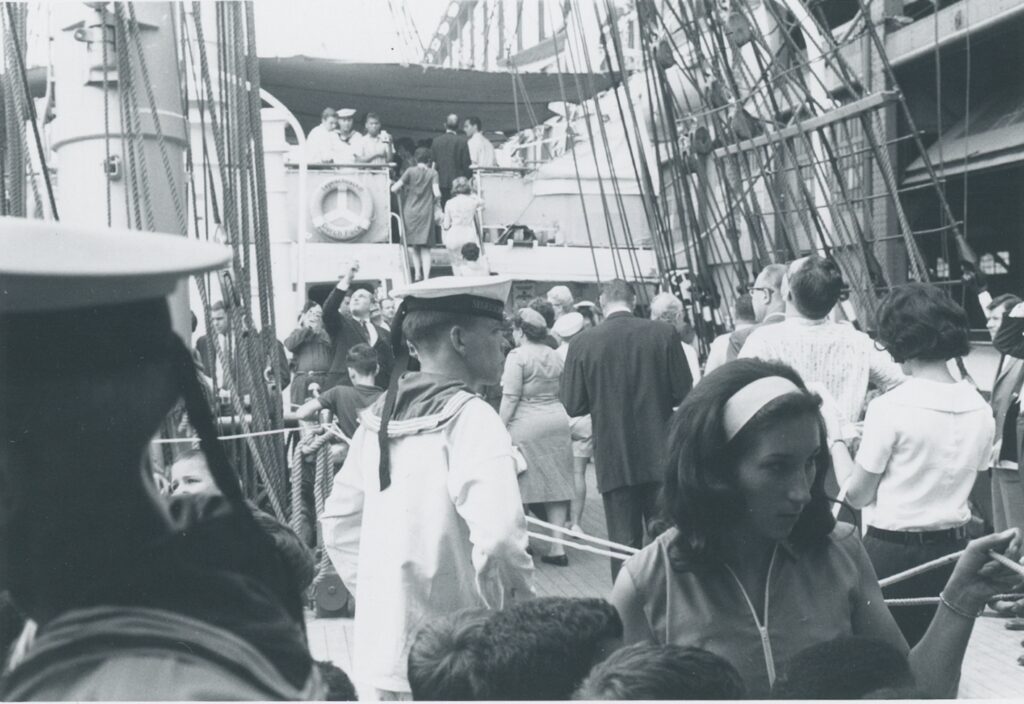
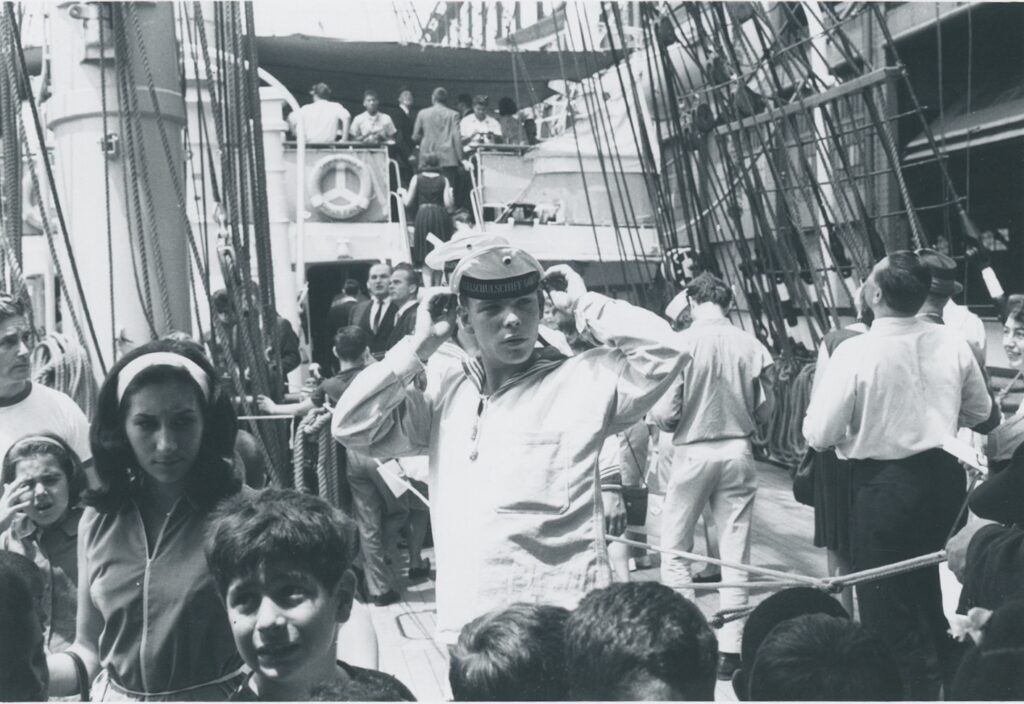
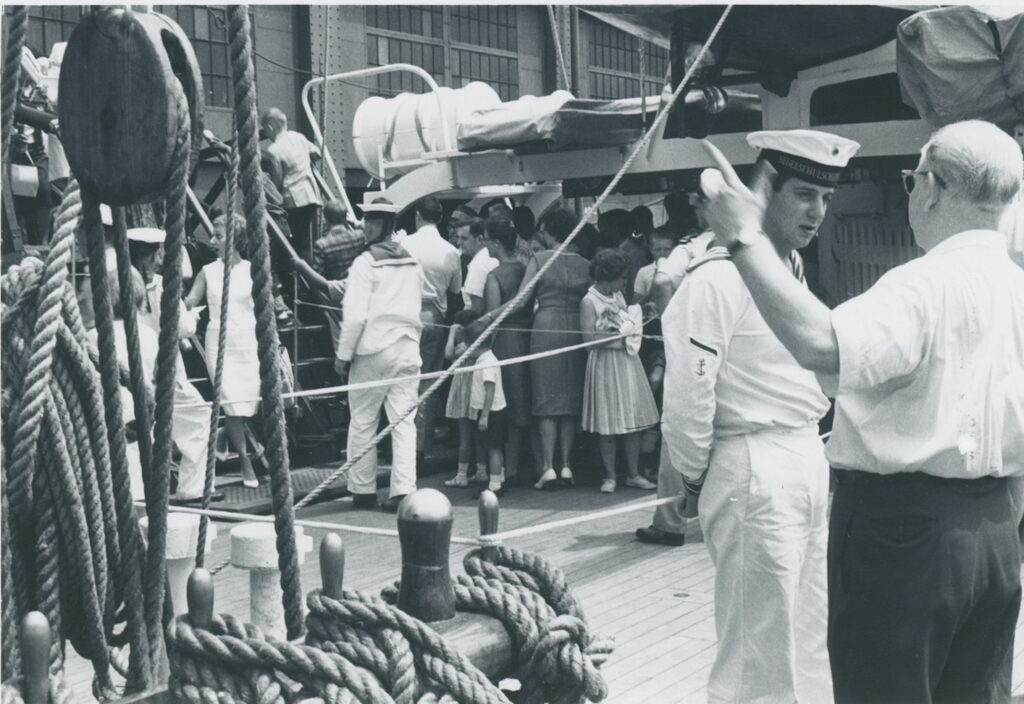
“Operation Sail, July 1964.” South Street Seaport Museum Archives
The first OpSail happened In 1964, at the same time of the 1964 World’s Fair. New York City’s Mayor Robert Wagner (1910-1991) proclaimed “Operation Sail Week” in honor of the visit of 23 sailing ships and their officers, cadets, and crewmen. The Boating magazine issue for January-June 1964 included an article titled Gathering of Great Ships by Anthony Anable, Jr., which described the origins and plans for the 1964 OpSail: “In this modern age of nuclear power and Polaris missiles, it may seem odd that so many nations train their naval and merchant marine cadets under sail. However, such training has many advantages, not the least of which is learning a respect for the sea – which makes equal demands of a huge carrier or a brigantine. There is no better way to gain an intimate knowledge of these natural forces than to serve in sail.”
On July 14, 1964, a parade of some of the world’s last windjammers took place through New York Harbor, and thanks to British Pathé, we can see a bit of it here.
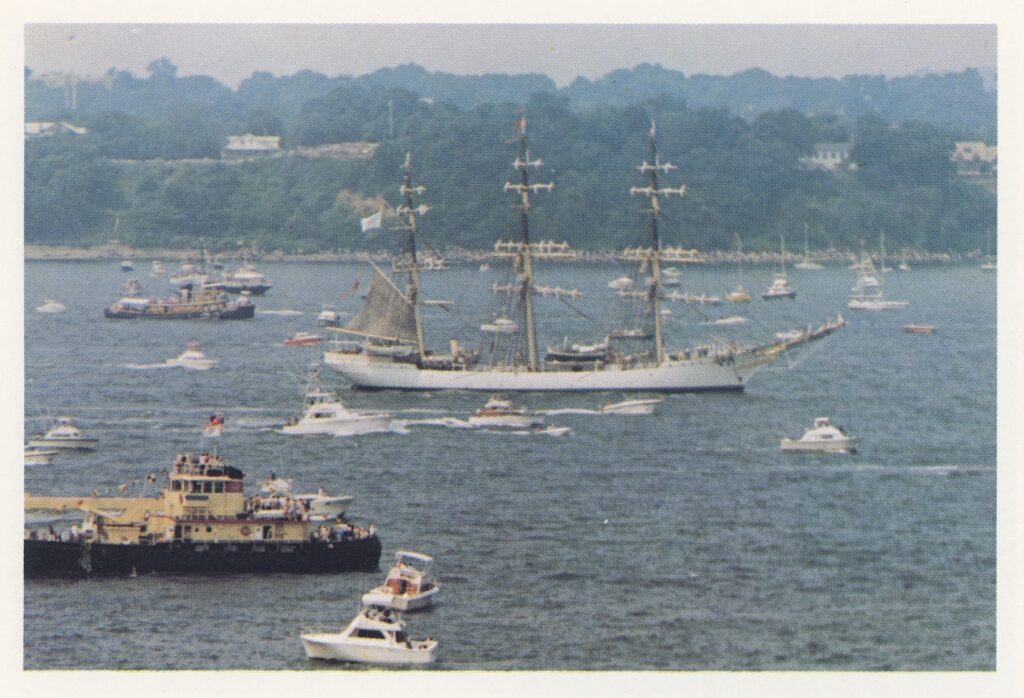
“Danmark visiting New York as part of OpSail 1976″ from Tow Line, Fall 1976, p. 15. South Street Seaport Museum Archives
Operation Sail was a demonstration of training under sail, as well as a reaffirmation of the fact that great sailing ships still span the seven seas. And luckily 1964 was not the first and only occasion to see such a gathering. In the years after the inaugural 1964 Operation Sail, OpSail ships returned to New York Harbor to celebrate the nation’s many landmark events, including among others the United States Bicentennial in 1976, and the Statue of Liberty Bicentennial in 1986.
On the occasion of the Bicentennial celebrations across the United States in 1976, Operation Sails organized a parade of 225 sailing ships from 30 nations, with the main parade on July 4th, 1776.
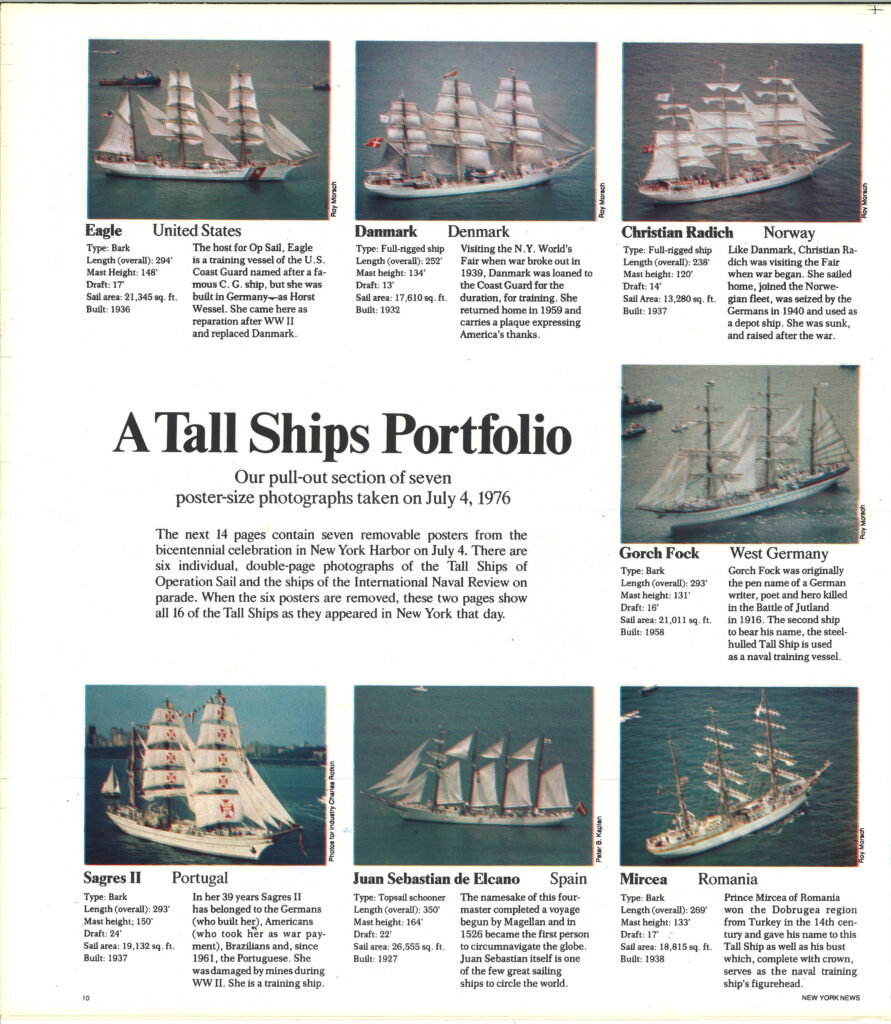
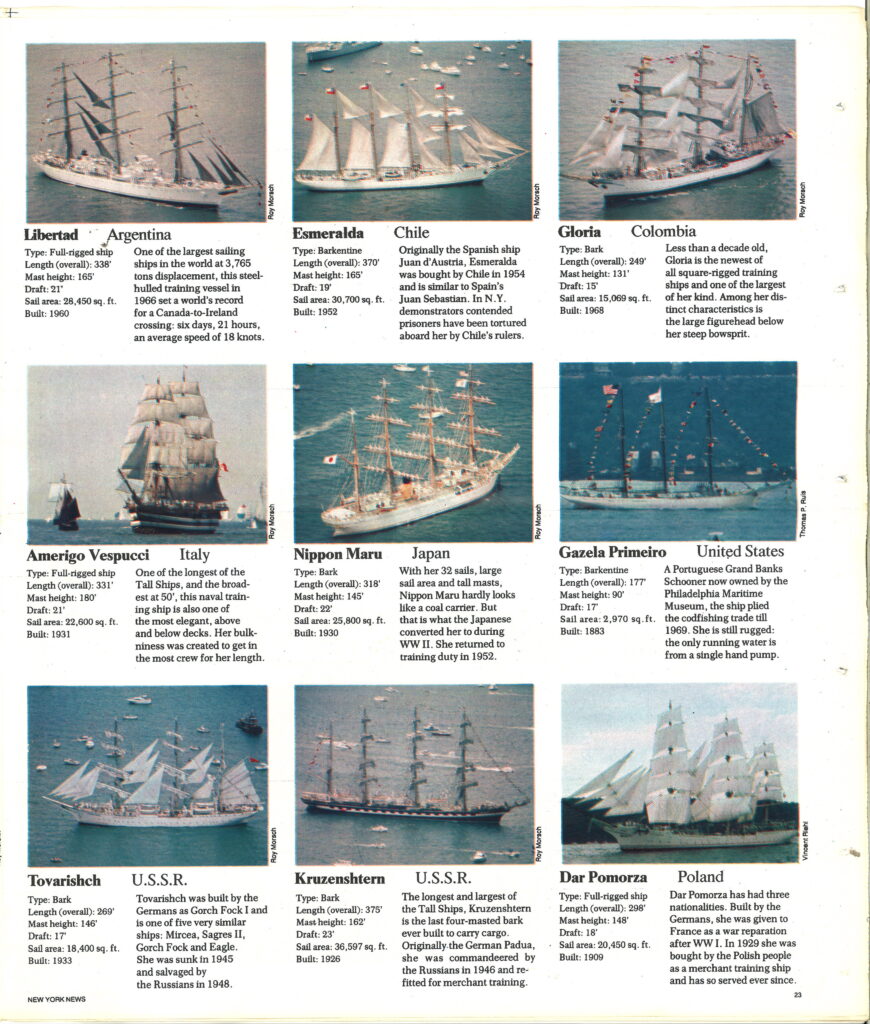
“OpSail Souvenir Issue” 1976, p. 10 and p. 23. South Street Seaport Museum Archives
The Bicentennial event, honoring the 200th anniversary of the signing of the Declaration of Independence, included 16 tall training ships from Argentina, Chile, Colombia, Denmark, Germany, Italy, Japan, Norway, Panama, Poland, Portugal, Romania, and even one ship from the Soviet Union. The ships raced from the Canary Islands to Bermuda, then proceeded “in company” to New York, where they were met by a vast spectator fleet.
Additionally, Operation Sail Bicentennial event partnered also with the United States Navy to bring back an International Naval Review in New York Harbor, a peacetime armada of 50 warships under as many flags, which was attended by President Gerald Ford (1913-2006) from the deck of the USS Forrestal.
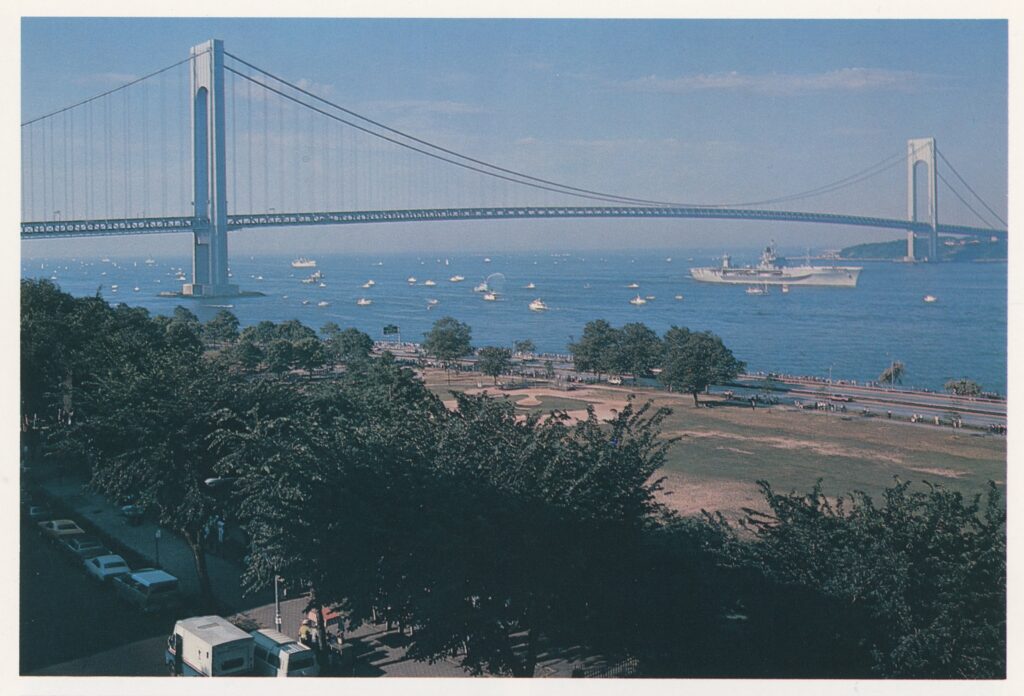
“International Naval Review” from Tow Line, Fall 1976, p. 15
One captain recalled of the event, “The hospitality of New Yorkers in 1976 has never been matched.” And according to Mayor Abe Beame, the Bicentennial celebration also helped to revive the spirits of the city, which had suffered from “a gloomy year of financial tribulations.”

Operation Sail 1986 celebrated the Statue of Liberty’s centenary with an even more diverse display of vessels representing an even greater number of countries –which in the organizer mind was a fitting tribute to what Lady Liberty represents in the eyes of generations of immigrants and their descendants.
”We’re giving a party, and we’ve asked the nations of the world to come to the party,” Howard Slotnick (1930-2020) – director of Operation Sail, which is organizing the event, as it did in 1976 – said at a news conference reported by the New York Times. ”In 1976, we asked them to come and celebrate our birthday. This year we are asking them here to thank them for what they have done for our nation.”
How Traditions Look Forward
Ten years after the last Operation Sail of 2012, the tall ship Danmark is being hosted by the South Street Seaport Museum during its visit to New York and will welcome visitors aboard to learn more about Denmark’s long maritime history and discuss contemporary sustainability issues on the occasion of Climate Week NYC 2022 (September 19–25).
Danmark is a ship that still functions as a training vessel for young people seeking careers at sea, as well as a floating sustainability ambassador. “Sustainability means different things to different people,” per Denmark’s official website. “To the Danes, sustainability is a holistic approach that includes renewable energy, water management, waste recycling, and green transportation including the bicycling culture.”
The arrival of Danmark at South Street is the 6th one documented in our archives, including three OpSails (1976, 1986, and 2000) and three other visits in 1968, 1974 and 1981.
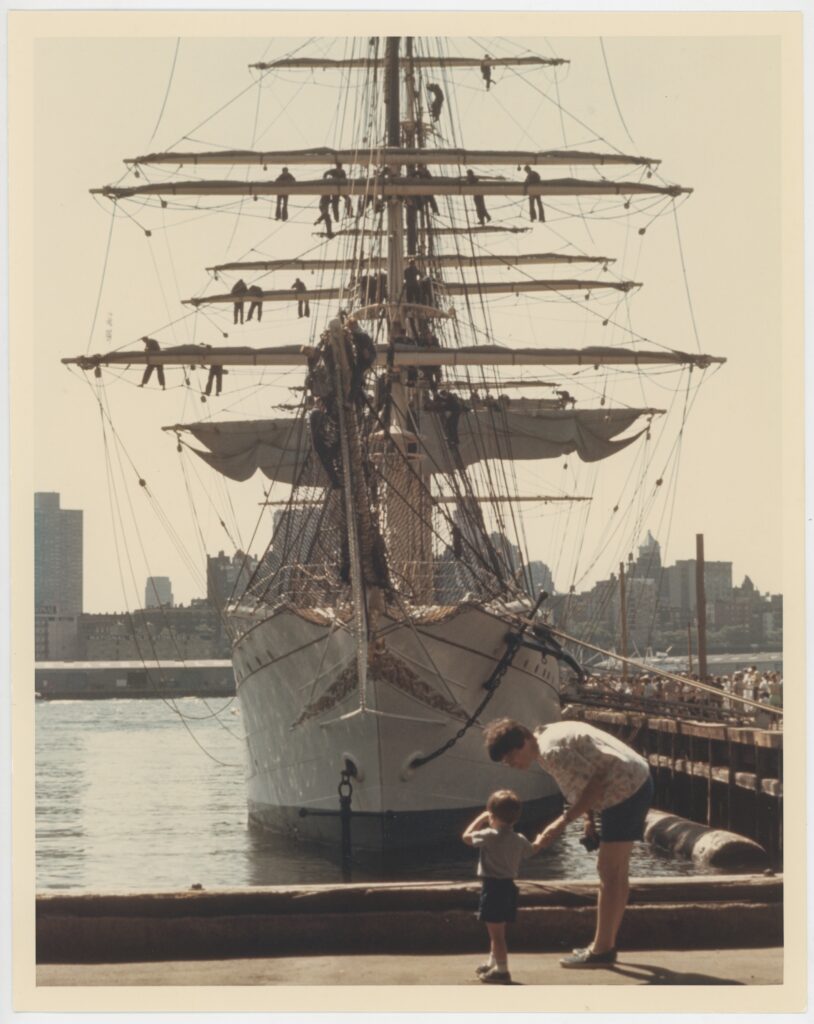
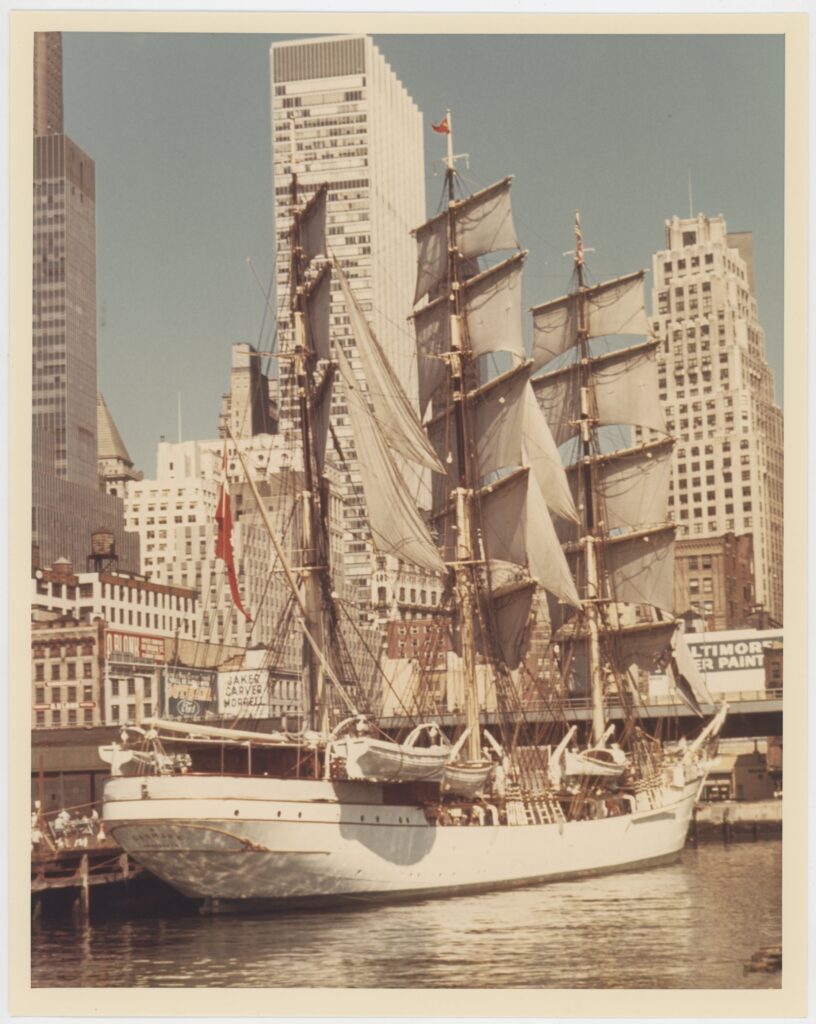
“Danmark visiting South Street, July 1968.” South Street Seaport Museum Archives
Danmark is hopefully the first of many more visiting vessels returning to South Street, continuing the value of bringing people to the waterways, capturing the imagination, forging connections, and today’s acting as a venue for discussing contemporary topics and opportunities tied to our oceans.
With this visit, we can show that New York Harbor remains more than just a venue for marine demonstration, but an inspiration for an ever evolving tradition.
Additional reading and resources
“[Diary entry: 23 April 1789]” National Archive Founders Online. Retrieved from The Rector and Visitors of the University of Virginia.
“Evacuation Day Parade, November 26th, 1883” Valentine’s Manual of Old New York, Volume 6, 1921, p. 251.
Theodore Roosevelt’s return to New York, 1910. Retrieved from the Library of Congress.
“Five Years Before the Mast” by Frank O. Braynard. The New York Times, July 4, 1976
“Port Enthralled: New York Harbor as Theater” by Norman Brouwer, Seaport Summer 1991, pp. 16-23
“The Long Blue Line: Danmark—the friend-ship between Denmark and the Coast Guard” by Nora L. Chidlow, archivist, United States Coast Guard, July 30, 2021.
“Media Monday: Windjammers Arrive at New York (1964)” Hudson River Maritime Museum Blog.
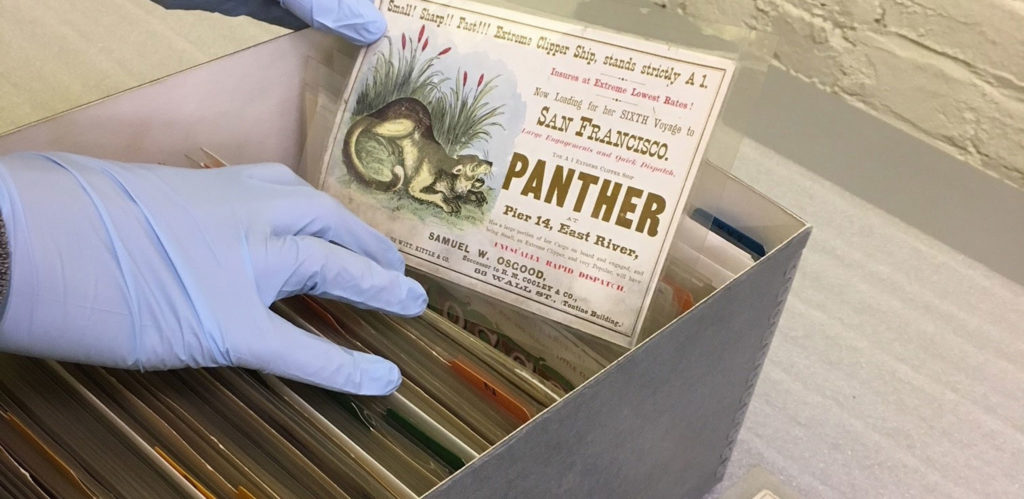
Collections Chronicles
Check out our bi-monthly blog where our collections team takes you behind the scenes and shares some of their work, inspiration, and more while highlighting hidden gems of history, the seaport, and our collection

